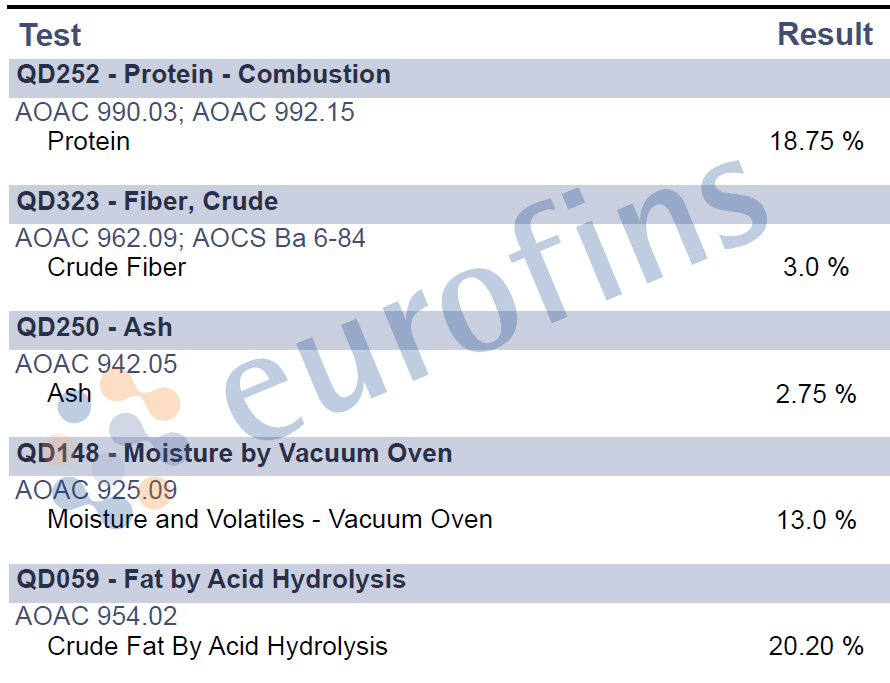Fur Your Consideration - Guaranteed Analysis

SEPTEMBER 2024 UPDATE: Please be aware that many states are in the process of implementing the Association of American Feed Control Officials’ (AAFCO) new guidelines, referred to as “Pet Food Label Modernization,” or shortened to “PFLM”. PFLM still includes the components of a guaranteed analysis panel but introduces additional nutritional components.
While many states currently follow guidelines that require only a guaranteed analysis to be present on pet foods (including treats,) some have already begun implementation of PFLM with the vast majority indicating they will require PFLM-compliant pet food labels within the next five years, and possibly sooner. Read more about PFLM requirements in our blog, Pet Food Label Modernization: What’s In, What’s Out, & How to Prepare for Changes.
Guaranteed Analysis: What is it all about?
Whether you’re considering selling your homemade pet treats or starting a new pet treat business, one of the first steps you may find yourself tasked with is determining what a guaranteed analysis is. Figuring out how to have a product tested and what information is pertinent can be intimidating – the information in this post is intended to get you started in the right direction.
What is a Guaranteed Analysis?
Minimally, guaranteed analysis as dictated by the Association of American Feed Control Officials (AAFCO) Model Regulations for Pet Food and Specialty Pet Food, is comprised of the following required guarantees:
- Minimum percentage of crude protein
- Minimum percentage of crude fat
- Maximum percentage of crude fiber
- Maximum percentage of moisture
These guarantees must be listed before any other claims, such as ash content or vitamins/minerals, for a treat or diet. Other claims for substances that are recognized in the AAFCO Dog/Cat Nutrient Profiles should immediately follow the required guarantees. Nutrients that are not recognized in the AAFCO Dog/Cat Nutrient Profiles must indicate that they are not recognized as an essential nutrient by the species-appropriate AAFCO Nutrient Profile. If you aren’t sure where you can find information on the species-specific nutrient profiles, we recommend purchasing the AAFCO Official Publication where this information is readily available. Note that products not intended to contribute fat, fiber, or protein to a pet’s diet are not required to include these parameters.
How often should you test each product for Guaranteed Analysis?
New businesses also find themselves tasked with determining how to evaluate their product for these specific nutrients. There are several factors that can lead to varying final-product results, including, but not limited to:
- Batch-to-batch ingredient differences
- Processing environment changes
- Test method analytical variation
- Sampling variation
Maybe you have access to robust, accurate ingredient data, as well as sophisticated software that allows you to calculate a guaranteed analysis on a final product based on ingredient inclusion. It doesn’t matter if the values come from calculation or testing. However, if the product is audited (analyzed) by a feed control official and does not corroborate the label claims, there could be serious implications for selling an inaccurately labeled product.
If you do not have access to an ingredient database or software to calculate the guaranteed analysis, analytical testing is likely the best route for you. Now the question is; Do I test my product once? Do I need to test it several times? Many times, testing a product once only provides a snapshot. Testing the same product several times from different batches is recommended to give a better picture of the potential batch-to-batch differences. Below is the data portion of an example report. This specific report is showing each result on an as-fed basis:

So you have the Guaranteed Analysis data, now what?
The most straightforward way of determining what to list as your guaranteed analysis is very simple. If you had multiple data points for each analyte from testing multiple batches of your product, you can:
- Locate the lowest number for protein – round down to the next whole percentage
- Locate the lowest number for fat – round down to the next whole percentage
- Locate the highest number for crude fiber – round up to the next whole percentage
- Locate the highest number for moisture – round up to the next whole percentage
We highly recommend reaching out to the governing bodies (many times the state department of agriculture) in each state the business would like to do business in, to ensure the respective requirements are met. AAFCO also has a list of state feed control officials that can assist with information required for sale of pet foods/commercial feeds in their state. It is pertinent that businesses comply with all federal and state regulations set for their product type(s).
Guaranteed analysis isn’t the only data manufacturers should be thinking about when developing a pet treat or pet food. Look for next month’s blog where we will discuss nutrient testing and other testing considerations for pet foods and treats.
 The Author
The Author
Kari Nichols, Senior Project Manager - Pet Nutrition
Eurofins Nutrition Analysis Center (Des Moines, IA)



